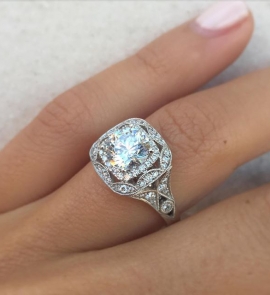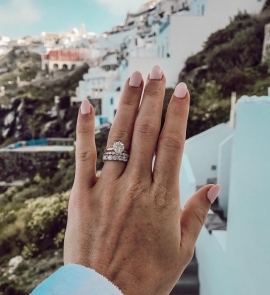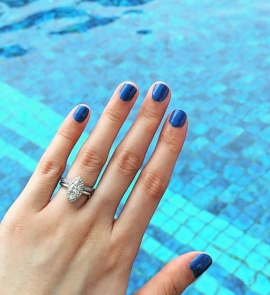There’s a lot that goes into finding the perfect engagement ring for that special someone and we know it can be super overwhelming at first! Here are the 8 things to ask your jeweler to ensure you get the best deal and quality.
Write them down, print them out, whatever it takes—don’t want to start ring shopping without them. Trust us, you’ll thank yourself later!
1.
Ask to see a trusted grading report.
This is where you’ll find info regarding all the 4C’s (if you need to brush up on what the 4C’s are, check out #2). Keep in mind that not all grading reports are created equal! Some labs grade their gems more strictly than others and when it comes to such a pricey purchase it’s vital to know not only the contents of the report but also exactly who completed it.
Two of the most reputable gem labs to remember are the GIA (Gemological Institute of America) and the AGS (American Gem Society Laboratories). If the grading report is not from either of these labs the jeweler should make you aware of it for consideration.
Nearly all retailers will explicitly tell you which lab has graded their diamonds. For example, if you go to James Allen, one of the leading online retailers, you’ll see Certificate: GIA is noted. Always be sure to check this when browsing!
2.
What are the stone’s 4C’s?
Cut, color, clarity and carat. Get your jeweler to go over the nitty gritty so you’re clear on the quality and value you’re getting. Here are some quick tips to make sure you ask the right questions about each.
#1 Cut
Like most aspiring diamond shoppers, you probably think of “cut” as the shape of the stone. Although wrong (kind of), you’re not alone. Yes, it refers to the shape the diamond is cut (i.e. round, oval, square) however, when you say “cut” to jewelers, it actually refers to the QUALITY of how the diamond was cut. More specifically, the diamond’s proportions, symmetry, brilliance, fire and polish of the diamond.
Quick Tip - Cut
For round stones, the most common shape, cut is the most important of the 4C’s. A high cut grade on a round diamonds can make up for compromises in clarity, color or even carat. For other fancy diamond shapes, the cut grade is more up to personal taste and style.
#2 Color
A diamond is given a color grade from D to Z that represents how white or colorless a diamond is. Think of this as a grading scale where D is the most colorless and Z includes noticeable brown and yellow tints.
Color is the second most important of the 4C's.
Quick Tips - Color
Ask to see the diamond in a complementary setting on its own. It’s too easy to see color on a white grading paper or side by side with a colorless diamond.
So why do you really need to know this? Well for purchasers, the color grade of a diamond often dictates the price and value of the stone. Make sure to consult with a diamond expert to determine the color grade they recommend for your desired carat size.
#3 Clarity
The small imperfections of a diamond, not only on the surface, but also internally.
The GIA (Gemological Institute of America) has established a diamond grading and clarity scale used to grade a stone that ranges from flawless (FL) to diamonds with imperfections/ inclusions (I3). You are probably more familiar with the clarity grades of VVS1 , VVS2 and even VS1. This range is popular because although there are considered to have very very slight imperfections, they are not visible to the naked eye. Consult with a diamond expert and have them show you “eye clean stones” where the setting can often hide certain inclusions so you don’t have to break the bank.
#4 Carat
The weight of the diamond.
Okay—most of us know what carat means, but there’s a lot of idiosyncrasies and details that go into what actually makes carats matter in the scope of the 4C's.
First off, it’s important to note that carat is actually the WEIGHT of the stone, not the size of its physical appearance (although they obviously can go hand in hand). There are definitely certain tricks to consider when it comes to the diamond carat size.
On Sparkly, we’ve made it super easy to pull up thousands of real ring examples in seconds. Every image is tagged with ring specs such as cut, color, clarity, carat size and more. Compare what a 0.80 carat vs a 1.00 carat round stone looks like on a ring size 6. What about a VVS1 vs a VS1? Can you really tell the difference? Your eye may not be able to recognize the difference, but your bank account sure will. Use Sparkly as a tool to identify exactly what ring details are important to you before you hit the jewelry store.
3.
What’s the origin of the stone?
It’s important for many to know that your diamond is responsibly sourced and conflict-free. Several jewelers can actually show you the entire journey of the diamond, from where it was mined to how it was shipped.
Be assured, that all jeweler partners on Sparkly offer ethically sourced stones. Visit our Shop section to view rings from our trusted jeweler partners.
4.
Is it possible to resize the ring?
It’s important that the ring fits at the time of the proposal, but you want to make sure it’s relatively easy to resize the ring if needed in the future.
Embellished bands with smaller diamonds such as pave or micro pave are harder to resize so be sure you get a full idea of what the jeweler’s resizing policy is on your ring style: Is the first resizing free? Is there a free resizing timeframe? Is there a cost associated with resizing?
A helpful Sparkly pre-shopping tip: grab one of your partner’s rings when they’re not looking and use the Sparkly ring sizer to determine her exact size before heading to the jewelry store. Doesn't hurt to confirm before shopping!
5.
Is there a return/exchange policy?
Not a fun one to think about, but you’ll want to know this just in case it’s not what she wanted. Make sure to cover your bases and ask how many days you have under the jeweler’s return policy and if there are any restocking fees.
Beyond a return policy, think into the future and be sure to ask about their upgrade policy. Ring and diamond upgrades are becoming extremely popular, so it’s good to know what your options will be. Many jewelers offer upgrade programs which include a credit equal to your original purchase price to apply to a new ring in the future so it’s definitely worth asking!
6.
Ask to see the ring under different lighting.
This is a question that many forget to ask! The engagement ring is something worn all day, out and about, so you want to make sure you get an accurate representation of how it will look under normal circumstances. Don’t be shy to ask your jeweler if you can take the diamond out of their jewelry store lighting and take a look in natural light to make sure you’re getting that certain sparkle you want.
On Sparkly, you won’t find highly produced glamour shots of rings or diamond stock images on our feed! All rings on Sparkly are real life ring photos from real people so that you can get a better idea of how different ring styles and specs translate in everyday life.
7.
Does the jeweler offer free cleaning or repairs for any time period?
Taking care of your ring is crucial to maintaining its value and preserving it for the future. You’ll want to get your diamond and setting cleaned on a regular basis so it’s worth asking if the jeweler offers free cleanings and if they do, for how long? A regular professional cleaning is recommended every 6 months, so you can make sure the integrity of your diamond is being upheld and their trained eye can call out any potential damage you may not be able to see. Learn more about how to care for diamond engagement rings and other methods of cleaning.
Also, before you purchase, don't forget to check out the jeweler’s warranty program in case of any damage or repairs needed in the future. Most policies will cover any manufacturing defects as well as offer maintenance services to keep your ring in tip-top condition for its lifetime.
8.
What wedding band would work best with the engagement ring?
So you just got the engagement ring… next up, the wedding band! Don’t forget to think about the whole picture even if you’re currently just shopping for the engagement ring. Many think of the wedding band as an afterthought and regret blowing the budget on the proposal ring.
There are so many different style options when it comes to wedding bands and it’s all based on personal style preferences. You can definitely ask the jeweler for style recommends and advice, or if you’re the browse and research type, you can use Sparkly’s filters to pull up examples of wedding band styles that have been paired with an engagement ring just like yours. For instance, if you purchased a round solitaire 1.5 carat engagement ring-- simply select those filters and turn on the switch to “show with wedding bands”. Instantly see examples of how other brides have paired similar ring sets and what styles are popular.
Already know what style wedding band you want to purchase? Shop now.






 Continue with Facebook
Continue with Facebook

Comments - 0 Comment